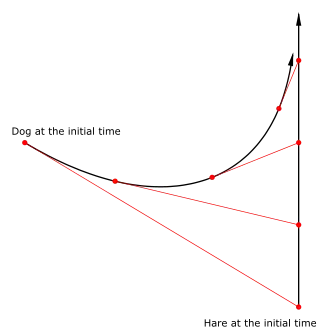In geometry, a radiodrome is the pursuit curve followed by a point that is pursuing another linearly-moving point. The term is derived from the Greek words ῥᾴδιος, rhā́idios, 'easier' and δρόμος, drómos, 'running'. The classic (and best-known) form of a radiodrome is known as the "dog curve"; this is the path a dog follows when it swims across a stream with a current after something it has spotted on the other side. Because the dog drifts with the current, it will have to change its heading; it will also have to swim further than if it had taken the optimal heading. This case was described by Pierre Bouguer in 1732.
A radiodrome may alternatively be described as the path a dog follows when chasing a hare, assuming that the hare runs in a straight line at a constant velocity.

Mathematical analysis
Introduce a coordinate system with origin at the position of the dog at time zero and with y-axis in the direction the hare is running with the constant speed Vt. The position of the hare at time zero is (Ax, Ay) with Ax > 0 and at time t it is
-
(1)
The dog runs with the constant speed Vd towards the instantaneous position of the hare.
The differential equation corresponding to the movement of the dog, (x(t), y(t)), is consequently
-
(2)
-
(3)
It is possible to obtain a closed-form analytic expression y=f(x) for the motion of the dog.
From (2) and (3), it follows that
-
.
(4)
Multiplying both sides with and taking the derivative with respect to x, using that
-
(5)
one gets
-
(6)
or
-
(7)
From this relation, it follows that
-
(8)
where B is the constant of integration determined by the initial value of y' at time zero, y' (0)= sinh(B − (Vt /Vd) lnAx), i.e.,
-
(9)
From (8) and (9), it follows after some computation that
-
.
(10)
Furthermore, since y(0)=0, it follows from (1) and (4) that
-
.
(11)
If, now, Vt ≠ Vd, relation (10) integrates to
-
(12)
where C is the constant of integration. Since again y(0)=0, it's
-
.
(13)
The equations (11), (12) and (13), then, together imply
-
.
(14)
If Vt = Vd, relation (10) gives, instead,
-
.
(15)
Using y(0)=0 once again, it follows that
-
(16)
The equations (11), (15) and (16), then, together imply that
-
.
(17)
If Vt < Vd, it follows from (14) that
-
(18)
If Vt ≥ Vd, one has from (14) and (17) that , which means that the hare will never be caught, whenever the chase starts.
See also
References
- Nahin, Paul J. (2012), Chases and Escapes: The Mathematics of Pursuit and Evasion, Princeton: Princeton University Press, ISBN 978-0-691-12514-5.
- Gomes Teixera, Francisco (1909), Imprensa da universidade (ed.), Traité des Courbes Spéciales Remarquables, vol. 2, Coimbra, p. 255
{{citation}}: CS1 maint: location missing publisher (link)